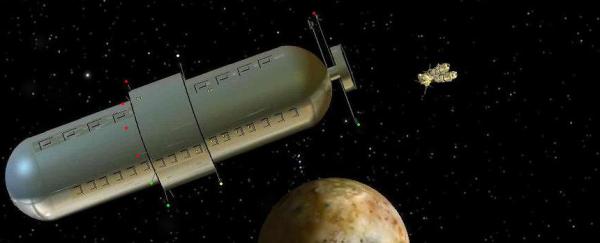BY LETTER
Io
The innermost Galilean moon of Jupiter in Solsys | |
 Image from Steve Bowers | |
| Gardenio Cylinder, a former Jovian League habitat orbiting Io | |
| Type | Ionian (EuHephaestian) Subtype |
|---|---|
| Primary, Position | Jupiter, v (all)/i (Galilean only) |
| Distance from Primary | 421,600 km |
| Satellites | none |
| Diameter | 3,630 km |
| Gravity | 0.183 G |
| Length of day | 1.769 days (tidally locked) |
| Atmosphere | mostly sulphur dioxide |
| Surface Temperature | -143° C (average) |
| Surface Composition | Silicates, sulphur, sulphur dioxide |
| Discovery | Jan 8, 1610 AD, by Galileo Galilei |
| Planetology | Holotype for Ionian Subtype of world. This moon, a body larger than Luna, is unlike any other object in Sol System, although a fairly common type in the right celestial environment. Volcanoes, lava-flows and lakes of bright orange molten sulphur dominate the surface of Io. There are extensive regions frosted with sulphur dioxide snow. |
Population: 300 million sophonts (90% To'ul'h tweaks, 5% T'oul'h adapted vecs, 5% all others).
Government: The Conservatory of Action - a hybrid mix of Terragen style cyberdemocracy and To'ul'h Polmusic-derived policy making. The Conservatory is a member of the Solsys Organization.
Planetary Surface: The interior of Io has been seeded with a modified Rheolithoid ecology, which has been designed such that a side effect of its operation is that the intensity and location of the moon's many earthquakes and volcanic eruptions are both mitigated and localized to regions that are deliberately left uninhabited (or mostly so - some thrill seeking groups and individuals have deliberately established settlements in these areas - they usually incorporate powerful transmitters to Backup facilities in orbit and tend to be rebuilt often). The more stable regions of the surface that remain have been extensively worldhoused and a tweaked To'ul'hian type environment established in most cases. A mixture of the To'ul'h population displaced by the terraformation of Venus (suitably modified for the low gravity and high sulfur conditions), their descendants and offspring, and emigrants who are interested in experiencing the Ionic To'ul'h lifestyle make up the bulk of the population.
Orbital Space: Io is surrounded by over a dozen orbital rings. The primary ring encircles the equator and supports a number of short beanstalks and a magnetic launch/docking system for traveling to and from local space and beyond. The remaining rings mount powerful magnetic field generators and work together to create an artificial magnetosphere for the moon to divert the intense particle flux of the Jovian radiation belts. The resulting auroras are often visible as naked eye events for those living within Jupiter local space and can be readily viewed with even a modest telescope across interplanetary distances.
Back to Solsys
Related Articles
Appears in Topics
Development Notes
Text by M. Alan Kazlev
Updated 5 November 2021 by Orion's Arm Editors
Initially published on 10 November 2001.
Updated 5 November 2021 by Orion's Arm Editors
Initially published on 10 November 2001.






